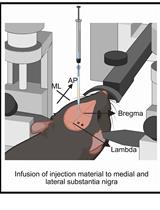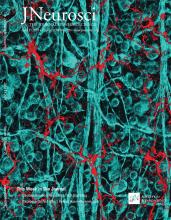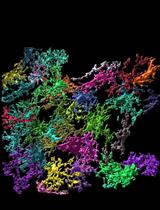- EN - English
- CN - 中文
Studying the Role of Microglia in Neurodegeneration and Axonal Regeneration in the Murine Visual System
小胶质细胞在小鼠视觉系统神经退变和轴突再生中的作用研究
发布: 2018年08月20日第8卷第16期 DOI: 10.21769/BioProtoc.2979 浏览次数: 12870
评审: Anonymous reviewer(s)

相关实验方案

基于 rAAV-α-Syn 与 α-Syn 预成纤维共同构建的帕金森病一体化小鼠模型
Santhosh Kumar Subramanya [...] Poonam Thakur
2025年12月05日 1406 阅读
Abstract
Microglia reside in the central nervous system (CNS) and are involved in the maintenance of the physiologic state. They constantly survey their environment for pathologic alterations associated with injury or diseases. For decades, researchers have investigated the role of microglia under different pathologic conditions, using approaches aiming to inhibit or eliminate these phagocytic cells. However, until recently, methods have failed to achieve complete depletion. Moreover, treatments often affected other cells, making unequivocal conclusions from these studies difficult. Recently, we have shown that inhibition of colony stimulating factor 1 receptor (CSF1R) by oral treatment with PLX5622 containing chow enables complete depletion of retinal microglia and almost complete microglia depletion in the optic nerve without affecting peripheral macrophages or other cells. Using this approach, we investigated the role of microglia in neuroprotection in the retina and axon regeneration in the injured optic nerve under different conditions. Thus, this efficient, reliable and easy to use protocol presented here will enable researchers to unequivocally study the contribution of microglia on neurodegeneration and axon regeneration. This protocol can be also easily expanded to other paradigms of acute and chronic injury or diseases in the visual system.
Keywords: Axon regeneration (轴突再生)Background
Microglia are resident immune cells of the central nervous system (CNS), which continuously scan their environment for pathologic alterations (Nimmerjahn et al., 2005). Upon detection of such conditions, microglia transform into an activated state and migrate towards the source where they perform different tasks (Kreutzberg, 1996; Davalos et al., 2005). Pathologic alterations, such as neurodegenerative diseases or acute injuries, are associated with neuronal loss and phagocytosis of these dying cells by activated microglia. Therefore, the overall assumption is that microglia are involved in this process (Thanos, 1991; Davalos et al., 2005; Hanisch and Kettenmann, 2007). Besides a possible effect of microglia on dying neurons, microglia are also part of the glial scar, which is formed at the lesion site and impairs axon regeneration in the CNS (Silver, 2004; Kitayama et al., 2011). However, as a clear discrimination of infiltrated blood born macrophages and microglia in the injured nerve was not feasible, the specific role of microglia in glial scar formation and axonal regeneration remained elusive (Silver, 2004; Hanisch and Kettenmann, 2007; Prinz and Priller, 2014; Hilla et al., 2017).
A suitable model to address the role of microglia in CNS degeneration and axonal regeneration is the visual pathway with its retinal ganglion cells (RGCs), whose axons project through the optic nerve (Leibinger et al., 2009; Fischer and Leibinger, 2012). Upon axonal damage, axons normally fail to regenerate (Thanos, 1991; Fischer et al., 2000). The degenerative and regenerative processes, following acute injury, can be easily visualized in retinal wholemounts and optic nerves, respectively as presented in the current protocol. Furthermore, the visual system and particularly RGCs are a suitable model to study neurodegenerative processes in chronic diseases such as multiple sclerosis or glaucoma (Kerrison et al., 1994; Howell et al., 2007; Diekmann and Fischer, 2013; Dietrich et al., 2018). In addition, the optic nerve is widely used as a classical model to study general regenerative failure in the CNS and strategies to facilitate axon growth (Fischer and Leibinger, 2012).
Several studies have been published, suggesting detrimental effects of microglia on RGC survival and axon regeneration whereas other studies indicate a beneficial, neuroprotective role (Thanos et al., 1993; Levkovitch-Verbin et al., 2006; Bosco et al., 2008; Chen et al., 2012; Rice et al., 2015). However, due to a paucity of depletion methods, many studies initially analyzed the contribution of microglia by altering their activation state with pharmacologic approaches (Thanos et al., 1993; Levkovitch-Verbin et al., 2006; Bosco et al., 2008; Jiao et al., 2014). In recent years, genetic methods were developed to achieve microglia depletion (Heppner et al., 2005; Bruttger et al., 2015; Waisman et al., 2015). However, apart from the requirement of transgenic animals, these methods have potential drawbacks such as the development of astrogliosis, secretion of pro-inflammatory cytokines and blood-brain-barrier damage, which complicate data interpretation. Only recently, pharmacologic colony stimulating factor 1 receptor (CSF1R) inhibitors PLX3397 and PLX5622 have been developed, which allow near complete depletion of microglia in the CNS independent of the animals genetic background (Elmore et al., 2014; Spangenberg et al., 2016; Hilla et al., 2017). In fact, we have recently demonstrated that an oral PLX5622 treatment for 21 days leads to a complete depletion of microglia in the retina and almost a total elimination in the optic nerve (Hilla et al., 2017). In accordance with previous studies, this approach selectively induces apoptosis of microglia by CSF1R inhibition, while other phagocytic cells such as peripheral macrophages are not affected (Elmore et al., 2014; Hilla et al., 2017). Although some studies suggested that this treatment causes minor astrocyte activation in the brain, we did not find any in the optic nerve or retina (Elmore et al., 2014; Hilla et al., 2017). Furthermore, as the inhibitor is orally bioavailable and capable of passing the blood brain barrier, PLX5622 can be formulated in standard rodent chow preventing the necessity of regular injections. Thus, this approach allows scientists to unequivocally address the role of microglia for different pathologic CNS paradigms, such as injury or chronic diseases, not only in the visual system, but also in other prominent CNS tissues such as brain and spinal cord. Using this approach in the visual pathway, we found that microglia neither affect the degeneration process of RGCs nor their capability to regenerate injured axons into the optic nerve upon an acute injury (Hilla et al., 2017). The current protocol describes the method for depleting microglia in the visual system and how effects on acute degeneration of RGCs and axon regeneration in the optic nerve can be quantified to identify the contribution of microglia in this context. This protocol can be easily expanded to investigate the involvement of microglia in other paradigms of acute and chronic injury or diseases in the visual system.
Materials and Reagents
- Glass capillary (World Precision Instruments, catalog number: 1B100F-6 )
- Glass slide (VWR, catalog number: 631-0108 )
- Surgical filament (Ethicon, catalog number: EH7790 )
- Scalpel blades (B. Braun Melsungen, catalog number: BB511 )
- Swabs (Lohmann & Rauscher, catalog number: 13356 )
- Nitrocellulose membrane (GE Healthcare, catalog number: RPN303E )
- Male and female mice aged between 6-10 weeks
- CSF1R-inhibitor PLX5622 (PLX, Plexxikon, commercially not available)
- AIN-76A standard rodent chow (Research Diets)
- Ketamine (Grovet, Alfasan, Medistar, catalog number: 10002 )
- Xylazine (Bayer, Rompun® 2% Injection 25 ml)
- Cholera toxin subunit B, Alexa FluorTM 555 (CTB) (Thermo Fisher Scientific, InvitrogenTM, catalog number: C22843 )
- Phosphate buffered saline (PBS) (Thermo Fisher Scientific, catalog number: 14190-094 )
- Paraformaldehyde (PFA) (Sigma-Aldrich, catalog number: 252549 )
- Sucrose (Sigma-Aldrich, catalog number: S9378 )
- KP-CryoCompound (KLINIPATH, catalog number: 1620-C )
- Double distilled H2O (Carl Roth, catalog number: 3478.2 )
- Eye ointment (DR. WINZER, Gent-Ophtal®)
- Methanol (Sigma-Aldrich, catalog number: 179957 )
- Triton X-100 (Sigma-Aldrich, catalog number: X100 )
- Iba1 antibody (Wako Pure Chemical Industries, catalog number: 019-19741 , RRID: AB_839504, LOT-specific concentration: 1 mg/ml)
- βIII-tubulin antibody (BioLegend, catalog number: 801202 , RRID: AB_2313773, LOT-specific concentration: 1 mg/ml)
- RNA-binding protein with multiple splicing (RBPMS) antibody (Abcam, catalog number: ab194213 , LOT-specific concentration: 0.25 mg/ml)
- Secondary antibodies
- Donkey serum (Bio-Rad Laboratories, catalog number: C06SB )
- Bovine serum albumin (Sigma-Aldrich, catalog number: A3294 )
- Tween 20 (Sigma-Aldrich, catalog number: P1379 )
- Paraformaldehyde (PFA) solution (see Recipes)
- Sucrose solution (see Recipes)
- Blocking solution (sections) (see Recipes)
- Blocking solution (wholemount) (see Recipes)
Equipment
- Jeweler's forceps (Fine Science Tools, catalog number: 11254-20 )
- Capsulotomy scissor (Hermle, catalog number: 564 )
- Mouse head holder (KOPF INSTRUMENTS, catalog number: 921-E )
- Cryostat (Leica Biosystems, model: CM3050 S )
- Fluorescence microscope (ZEISS, model: Axio Observer.D1 )
- Confocal laser scanning microscope (Leica Microsystems, model: Leica TCS SP8 )
- Binocular (ZEISS, model: Stemi DV4 SPOT )
- Cold light source (SCHOTT, model: KL 1600 LED )
Software
- Excel 2016 (Microsoft)
- SigmaStat 3.1 (Systat)
- Photoshop CS6 (Adobe)
Procedure
文章信息
版权信息
© 2018 The Authors; exclusive licensee Bio-protocol LLC.
如何引用
Readers should cite both the Bio-protocol article and the original research article where this protocol was used:
- Hilla, A. M. and Fischer, D. (2018). Studying the Role of Microglia in Neurodegeneration and Axonal Regeneration in the Murine Visual System. Bio-protocol 8(16): e2979. DOI: 10.21769/BioProtoc.2979.
- Hilla, A. M., Diekmann, H. and Fischer, D. (2017). Microglia are irrelevant for neuronal degeneration and axon regeneration after acute injury. J Neurosci 37(25): 6113-6124.
分类
神经科学 > 神经系统疾病 > 动物模型
神经科学 > 细胞机理 > 小神经胶质
您对这篇实验方法有问题吗?
在此处发布您的问题,我们将邀请本文作者来回答。同时,我们会将您的问题发布到Bio-protocol Exchange,以便寻求社区成员的帮助。
Share
Bluesky
X
Copy link










